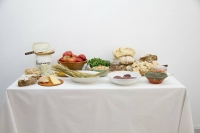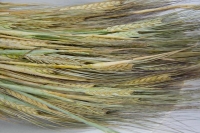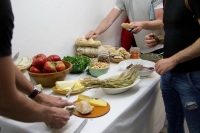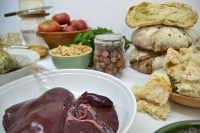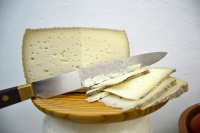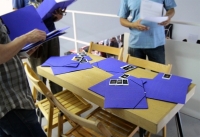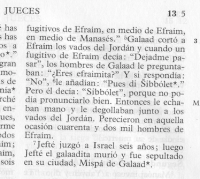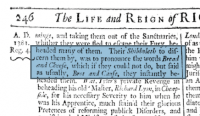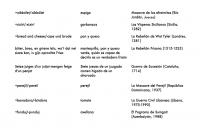EN: Judges 12:5-6 tells how the Gileadites rooted out and massacred the Ephraimites trying to ford the River Jordan by making them pronounce the Hebrew word shibbólet, which in the Ephraimites’ dialect was pronounced sibbólet. Based on this episode the term "shibboleth” has come to refer to a type of code word whose phonetic characteristics make it possible to identify whether or not a person belongs to a language group. The names of all of the foods on display in this installation have been used as shibboleths, in nine separate massacres carried out in different times and places. In this work I reflect on language and food as identity traits; these extreme cases – where the pronunciation of a food word is a matter of life or death – illustrate that food and language are not just a tie that binds, but a barrier that excludes as well.
When one enters the installation they first see the still life composition of foods and hear a recording of words and phrases in different languages, some familiar some quite foreign. This recording emanates from a second space containing a table full of folders with documentation about each of the nine massacres involving food-related shibboleths.
Read more on Practice Sharing, a platform for language-based artistic research.
ES: Jueces 12:5-6 relata cómo los gileaditas detectan y masacran a los efraimitas que intentan cruzar el Jordán haciéndoles pronunciar la palabra hebrea xibbólet (“espiga”), que en el dialecto efraimita se pronunciaba sibbólet. A partir de este episodio el término “shibboleth” ha pasado a significar un tipo de palabra clave cuyas características fonéticas permiten identificar si alguien pertenece o no a un determinado grupo lingüístico. Los nombres de todos los alimentos presentes en esta instalación se han utilizado como shibboleth, en nueve masacres ejecutadas en diversos lugares y periodos históricos. Con esta obra planteo una reflexión sobre la lengua y la comida como rasgos identitarios; estos casos límite – donde la pronunciación del nombre de un alimento puede marcar el límite entre la vida y la muerte – demuestran que la comida y la lengua constituyen no solo un vínculo de unión, sino también un criterio de exclusión.
Al entrar en la instalación primero se se ve la mesa del bodegón a la vez que se escucha una grabación de palabras y frases en diversos idiomas, algunos conocidos y otros totalmente extraños. Esta grabación guía al espectador hacia otro espacio que contiene una mesa llena de carpetas con documentación sobre cada una de las nueve masacres en las que se utilizó el nombre de algún alimento como shibboleth.
